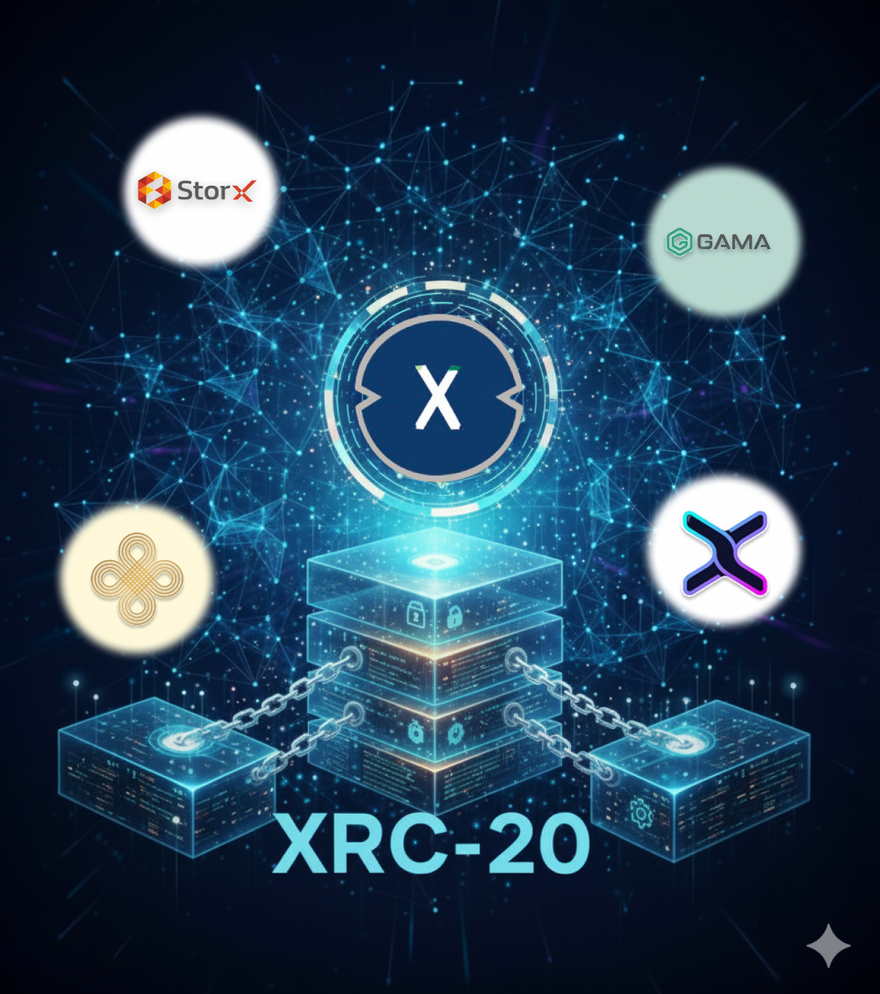In the world of blockchain technology, tokens play a fundamental role in representing value, assets, and rights on decentralized networks. From cryptocurrencies and stablecoins to NFTs and governance tokens, each serves a unique purpose. However, to ensure interoperability, security, and uniform behavior across applications, token standards were introduced. These standards define how tokens are created, managed, and transferred within a blockchain ecosystem.
The XDC Network is EVM-compatible, meaning it supports Ethereum-based token standards and follows the same rules used across the EVM ecosystem. Its native token standard, XRC-20, works similarly to ERC-20, allowing developers to create reliable, interoperable, and scalable tokens on the XDC blockchain. This ensures smooth integration with wallets, dApps, and smart contracts across the network.
What Are Token Standards?
A token standard is a set of rules and guidelines that dictate how tokens on a blockchain should function. These rules ensure that tokens behave consistently and are compatible with various wallets, exchanges, and decentralized applications (dApps).
Without token standards, every project might implement tokens differently—making integration difficult and reducing trust among users and developers. By adhering to standardized frameworks, tokens can easily interact with the broader blockchain ecosystem.
Why Token Standards Matter
Interoperability:
Standards ensure tokens can be recognized and used across multiple platforms and applications seamlessly.
Security:
Well-audited standards reduce vulnerabilities by providing a tested and reliable foundation for token creation.
Ease of Development:
Developers can build on proven templates instead of starting from scratch, saving time and reducing errors.
Ecosystem Growth:
Standardized tokens foster broader adoption by enabling tools, wallets, and exchanges to support them easily.
1) ERC-20
The ERC-20 token standard is a set of rules used to create fungible tokens on the Ethereum blockchain. These tokens follow a standard “recipe,” meaning every ERC-20 token behaves the same way and supports the same basic functions—like checking balances, sending tokens, and approving transfers. This consistency allows ERC-20 tokens to work smoothly across wallets, exchanges, and dApps, making it one of the most widely used standards for creating cryptocurrencies, stablecoins, and **DeFi **tokens.
Similarly, the XRC-20 token standard follows the same “recipe” as ERC-20 but is specifically designed for the XDC Network. Since XDC is EVM-compatible, XRC-20 tokens operate just like ERC-20 tokens while benefiting from XDC’s faster transactions, low fees, and energy-efficient blockchain. This makes XRC-20 an ideal standard for creating reliable and scalable digital assets within the XDC ecosystem.
See ERC-20 token here : https://etherscan.io/tokens
See XRC-20 token here : https://xdcscan.io/tokens
2) ERC 721
The ERC-721 token standard is a set of rules on the Ethereum blockchain used to create non-fungible tokens (NFTs). Unlike ERC-20 tokens, which are identical and interchangeable, ERC-721 tokens are unique, each with its own identity, value, or metadata. This makes them perfect for digital collectibles, artwork, in-game assets, real estate, and any item that is one of a kind. Each ERC-721 token has its own unique ID and can store details like names, descriptions, or links to digital files. With functions like ownerOf, transferFrom, and approve, the standard ensures wallets and marketplaces can easily recognize and manage NFTs. ERC-721 played a major role in the rise of NFTs, powering platforms like OpenSea and famous projects like CryptoKitties.
Likewise, the XRC-721 standard brings the same NFT functionality as ERC-721 but is tailored for the XDC Network. Thanks to XDC’s EVM compatibility, XRC-721 tokens operate just like traditional Ethereum NFTs, while gaining the advantages of faster transaction speeds, lower gas costs, and a more energy-efficient infrastructure. This makes XRC-721 a strong choice for building and managing unique digital assets across the XDC ecosystem.
See ERC-721 token here : https://etherscan.io/nft-top-contracts
See XRC-721 token here : https://xdcscan.io/nft-top-contracts
3) ERC 404
The ERC-404 token standard is an experimental hybrid on Ethereum that mixes features of both ERC-20 and ERC-721. It creates “semi-fungible tokens,” which means tokens can act like normal tradable coins while still being linked to unique NFTs. ERC-404 makes fractional NFT ownership possible — small token pieces can represent parts of an NFT, and collecting enough pieces can automatically form a full NFT again. This gives NFTs more liquidityand flexibility for gaming, DeFi, and digital assets. Although popularized by projects like Pandora, ERC-404 is still experimental and not an official Ethereum standard yet.
On the XDC Network, the XRC-404 standard brings the same hybrid concept as ERC-404 but adapts it for XDC’s efficient, EVM-compatible environment. It allows tokens to behave as both fungible and NFT-linked assets, enabling seamless fractional ownership and recombination into full NFTs. With XDC’s faster transactions, lower gas fees, and eco-friendly design, XRC-404 offers a powerful and scalable way to build advanced digital asset and fractionalized NFT systems within the XDC ecosystem.
See XRC-404 token here : https://xdcscan.io/tokentxns/xrc404
4) ERC-1155
The ERC-1155 token standard is a flexible system on the Ethereum blockchain that lets developers create many types of tokens—fungible, non-fungible, and even semi-fungible—within a single smart contract. Before ERC-1155, each token type required its own contract, which was slower and more costly. With ERC-1155, everything can be managed together, making transactions faster, reducing gas fees, and improving efficiency. This makes it perfect for use cases like gaming, where coins, unique items, and power-ups can all be handled in one place.
On the XDC Network, the XRC-1155 standard brings the same multi-token capabilities but takes advantage of XDC’s faster finality, low transaction costs, and energy-efficient design. Developers can create and manage fungible tokens, NFTs, and semi-fungible assets within a single contract while benefiting from the scalability of the XDC ecosystem. This makes XRC-1155 ideal for advanced applications such as gaming, asset tokenization, and digital collectibles on the XDC Network.
See ERC-1155 token here : https://etherscan.io/nft-top-contracts
See XRC-1155 token here : https://xdcscan.io/nft-top-contracts
Conclusion
Token standards are essential for keeping the blockchain ecosystem organized, secure, and interoperable. They give developers a reliable framework for creating assets that work smoothly across wallets, dApps, and exchanges. From ERC-20 to ERC-721, ERC-1155, and even the experimental ERC-404, each standard plays a unique role in shaping how digital assets are designed and used.
Because the XDC Network is fully EVM-compatible, it supports equivalent standards like XRC-20, XRC-721, XRC-1155, and XRC-404, allowing developers to enjoy the same functionality but with faster transactions, lower fees, and improved scalability. As blockchain technology continues to evolve, these standards—across Ethereum and XDC—will keep pushing the digital asset ecosystem toward greater efficiency, innovation, and global adoption.
Follow us for more such content











Discussion (0)